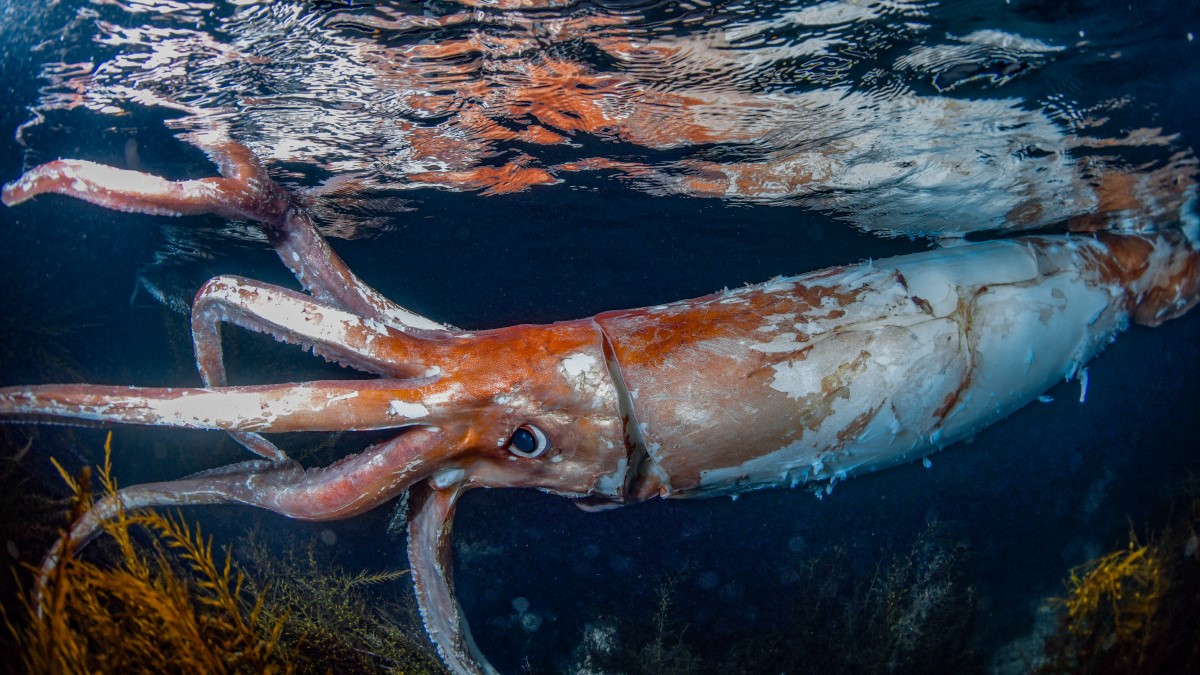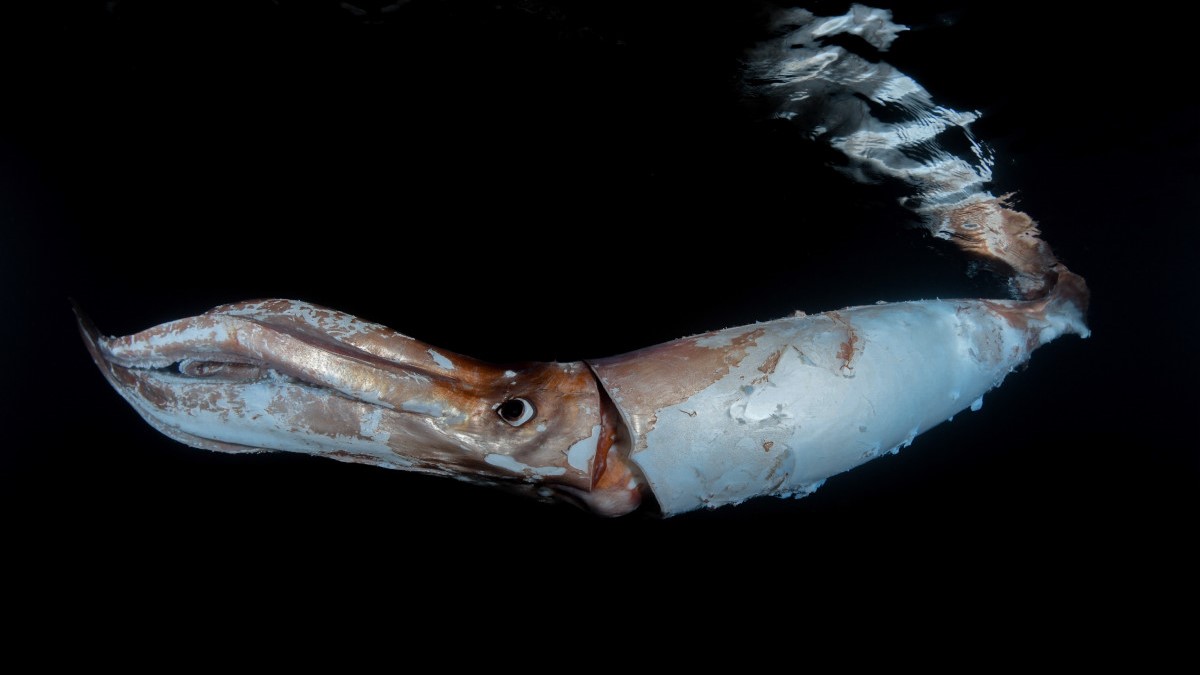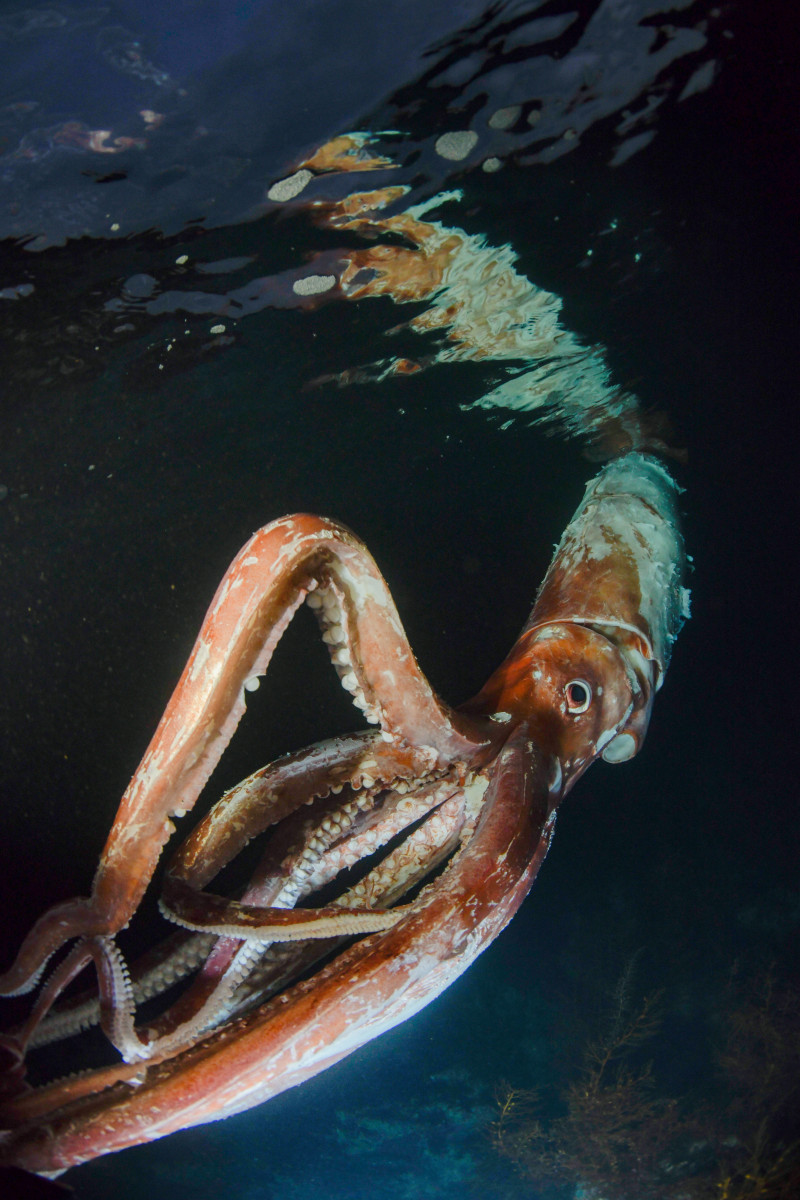Diver captures stunning photos of rare 8-foot giant squid
Diver Yosuke Tanaka swam with a giant squid in the Sea of Japan near Toyooka City in Hyogo Prefecture.

A diver in Japan swam alongside an unusual companion earlier this month: An 8.2-foot-long (2.5 meter) giant squid.
Yosuke Tanaka, who co-runs Dive Resort T-Style with his wife in Toyooka City, Japan, got the opportunity on Jan. 6 when a local ferryman called him to say that there was a large squid swimming near the surface off the coast in the Sea of Japan. Tanaka hurried over, he wrote on his blog, and was rewarded with a close-up encounter with one of the ocean's most mysterious creatures.
It was the first time he'd ever swum with a giant squid (Architeuthis dux), Tanaka told Live Science in an email.
"I felt a little scared because it was so big," he said.
Related: Giant squid filmed alive for second time in history. Here's the video.
Giant squid typically live in the deep ocean, so they're often only seen as corpses washed ashore or as accidental bycatch in fishing nets. They can grow to 40 to 45 feet (12 to 14 meters) long, a size even more incredible considering that the animals likely only live about five years in the wild, according to the Smithsonian Institution. Their elusive nature means little is known about their daily lives or mating habits, though investigations of their guts reveal that they eat fish and other squid. They're also often found in the stomachs of sperm whales, indicating that they aren't just hunters, but are also hunted.
Though most people won't get a chance to swim alongside a giant squid, Tanaka's encounter was not so surprising to squid scientists.
Get the world’s most fascinating discoveries delivered straight to your inbox.
"It's unusual any place other than where they saw it," said Michael Vecchione, a zoologist and cephalopod expert at the Smithsonian National Museum of Natural History in Washington, D.C. "Actually, in the Sea of Japan it turns out that it's fairly common to see giant squids at this time of year."
Japanese zoologist Tsunemi Kubodera, who captured the first photographs and video of living giant squid in their native habitats, has documented large numbers of giant squid between January and March in the coastal waters of the Sea of Japan. In a 2016 paper, Kubodera and his colleagues reported finding 57 giant squid in just those three months, 28 of which were alive.
The squid, unfortunately, do not fare well in this region at this time of year. According to Kubodera's research, the squid travel through the Tsushima Strait between South Korea and Japan as part of their typical north-south migration. Those that time the migration wrong, however, get trapped by cold water at the depths where they usually swim.
"When that happens, they can't stay in the really deep water that they usually stay in," Vecchione told Live Science. "They come up close to the surface, and then the surface water gets cold. When you see them up close to the surface, they're not healthy."
Tanaka's video shows a squid in rough shape, said Sarah McAnulty, a squid biologist who runs a Squid Facts hotline ( Text "SQUID!" to 1-833-724-8398) and the executive director of Skype a Scientist, a science outreach program.
"You can tell this squid is approaching the end of its life by looking at its skin," McAnulty told Live Science in an email. "A healthy giant squid should have smooth shiny skin and be kinda red. This poor thing has been through it!"
Tanaka said he swam near the squid for about a half-hour. The squid was swimming slowly, he said, but was trying to move away from him.
Though giant squid have a fearsome reputation in literature — think "20,000 Leagues Under the Sea" by French writer Jules Verne — the chance of anyone being attacked by a giant squid is extremely small, Vecchione said. The only encounters with humans tend to be when people poke or prod at the squid, as in a 2017 incident caught on video when a surfer lassoed an injured juvenile squid, which then wrapped its tentacles around the surfboard. No humans were injured.

Stephanie Pappas is a contributing writer for Live Science, covering topics ranging from geoscience to archaeology to the human brain and behavior. She was previously a senior writer for Live Science but is now a freelancer based in Denver, Colorado, and regularly contributes to Scientific American and The Monitor, the monthly magazine of the American Psychological Association. Stephanie received a bachelor's degree in psychology from the University of South Carolina and a graduate certificate in science communication from the University of California, Santa Cruz.
 Live Science Plus
Live Science Plus








